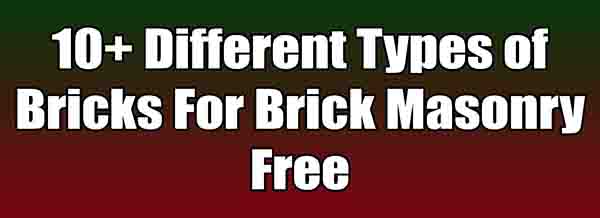
There are Different types of bricks, including common bricks, engineering bricks, facing bricks, and fire bricks. Each type serves specific purposes in construction, offering different strengths and appearances.
Different Types of Bricks
- Common Bricks: Standard clay bricks used for general construction.
- Engineering Bricks: Dense and strong, suitable for structural purposes.
- Facing Bricks: Aesthetic bricks used for exterior walls to enhance appearance.
- Fire Bricks: Heat-resistant bricks used in fireplaces, kilns, and furnaces.
- Concrete Bricks: Made from concrete, offering strength and durability.
- Hollow Bricks: Contain voids to reduce weight and improve insulation.
- Sand Lime Bricks: Made from sand, lime, and water, often used in construction.
- Fly Ash Bricks: Made from fly ash, a waste product from coal combustion.
- Perforated Bricks: Contain holes for better insulation and reduced weight
- Bullnose Bricks: Rounded on one end, often used for decorative purposes.
Common Bricks
Common bricks, also known as building bricks or clay bricks, are the standard bricks used in construction. They are typically made from clay, molded into rectangular shapes, and then fired in a kiln.
Common bricks are known for their versatility and are widely used for various building purposes such as walls, pavements, and foundations.
They come in different sizes and colors, and their composition may vary based on the specific requirements of the construction project.
Engineering Bricks
engineering bricks are high-strength, durable bricks designed for structural applications. they possess low water absorption, high density, and are fired at higher temperatures than common bricks. these characteristics make engineering bricks resistant to frost and capable of handling heavy loads.
They are commonly used in construction projects where strength and robustness are crucial, such as in foundations, load-bearing walls, and areas exposed to harsh weather conditions. engineering bricks are typically dense and have a smooth, dense surface finish.
Facing Bricks
Facing bricks, also known as face bricks or veneer bricks, are designed for aesthetic purposes and are used on the visible surfaces of a building.
These bricks are chosen for their appearance and texture rather than structural strength. Facing bricks come in various colors, textures, and finishes, allowing for creative and decorative building designs.
They are often employed to enhance the exterior appearance of buildings and provide a pleasing finish. While facing bricks contribute to the visual appeal, a structural support system typically relies on other types of bricks or materials.
Fire Bricks
Fire bricks, also known as refractory bricks or heat-resistant bricks, are specially designed to withstand high temperatures. These bricks are made from refractory ceramic materials, which can endure intense heat without deforming or breaking down.
Fire bricks are commonly used in applications where exposure to elevated temperatures is a concern, such as in fireplaces, kilns, furnaces, and pizza ovens.
Their ability to withstand heat makes them crucial for creating a barrier that protects surrounding materials from extreme temperatures in various industrial and domestic settings.
Concrete Bricks
Concrete bricks are building materials made from a mixture of cement, sand, and aggregates, such as gravel or crushed stone.
These bricks are formed by compressing the concrete mixture into a mold and allowing it to cure and harden. The resulting product is a solid and durable brick that can be used in various construction applications.
Hollow Bricks
Hollow bricks, also known as hollow concrete blocks or hollow concrete masonry units (CMUs), are building blocks made from concrete with hollow cores. These voids or cavities within the bricks reduce the overall weight of the block and provide several advantages in construction.
Hollow bricks are often used in the construction of load-bearing walls. The hollow cores reduce the overall weight of the bricks, making them more manageable, and also provide space for reinforcement and insulation.
Hollow bricks are used for constructing partition walls in buildings. Their lighter weight makes them easier to handle, and the hollow cores can be filled with insulating materials for improved thermal performance.
Sand Lime Bricks
Sand lime bricks, also known as calcium silicate bricks, are a type of construction material made by mixing sand, fly ash, and lime.
The bricks undergo a chemical process called hydration, where calcium oxide reacts with water to form calcium hydroxide, binding the sand particles together. Sand lime bricks are known for their strength, durability, and versatility.
Fly Ash Bricks
Fly ash bricks are a type of building material that is made by mixing fly ash, a byproduct of coal combustion, with other materials such as cement, lime, and water.
These bricks are an alternative to traditional clay bricks and are considered more environmentally friendly due to the utilization of fly ash, which would otherwise be disposed of as waste.
Fly ash bricks are widely used in the construction of residential buildings for both load-bearing and non-load-bearing walls.
These bricks are suitable for constructing commercial and industrial buildings, providing a cost-effective and environmentally friendly alternative to traditional clay bricks.
Perforated Bricks
Perforated bricks, also known as perforated clay bricks or perforated bricks, are bricks that have holes or perforations through their structure.
These holes can be of varying sizes and shapes and are deliberately created during the manufacturing process. Perforated bricks are commonly used in construction for both functional and aesthetic purposes.
Bullnose Bricks
Bullnose bricks are specialized bricks that have one or more rounded corners or edges. The term “bullnose” refers to the smooth, curved shape resembling the rounded nose of a bull.
These bricks are designed to provide a soft, rounded edge as opposed to the sharp corners of regular bricks. Bullnose bricks serve both practical and aesthetic purposes in construction.
Bullnose bricks are frequently used to edge steps and stairs, providing a rounded and safer transition between different levels. The rounded edge reduces the risk of injury and enhances the visual appeal.
Download Our App
“Vlcinfo” is an Educational App where you will be able to find details about various Job Related Updates, Test Series, Results, Syllabus, Old Papers, Video Lectures, MCQs Practice and much more.

App Features :
- Job Related Updates
- Test Series
- Video Lectures
- Study Materials
- Current Affairs
- Old Papers
- MCQs Practice
Civil Engineering Study Materials
- What is Cadastral Map?
- Signals and Systems Free Study Material PDF
- Landscape Architecture Free Study Material PDF Download
- Database Management System Free Study Material PDF
- Wireless Communication: Definition & Different Types
- Database Management System: Important Terms
- ArcGIS: Introduction & Overview
- Signals and Systems: Definition & Classification
- GSSSB Senior Surveyor Study Materials Free 2024
- GSSSB Surveyor Study Materials (Class 3) Free 2024
- Earthquake Terminology: Epicenter, Focus, Waves Free 2024
- Construction of Earthquake Resistant Building Free 2024
- Earthquake Management And Mitigation Free 2024
- Earthquake Definition, Causes And Its Effects Free 2024
- Applications of Seismic Engineering In Civil Eng. Free 2024
- Seismic Engineering Definition And Its Principles Free 2024
- Green Building Concepts, Materials And Importance Free 2024
- Types of Environmental Audit And Its Importance Free 2024
- Air Pollutants: Primary And Secondary Pollutants Free 2024
- Environmental Impact Assessment (EIA) Process Free 2024
- Water Pollution, Types, Causes And Its Solution Free 2024
- Environmental Pollution, Sources And Its Effects Free 2024
- Environmental Issues, Causes And Its Solution Free 2024
- Eco-System Definition, Components And Processes Free 2024
- Environment Definition, Importance And Components Free 2024
